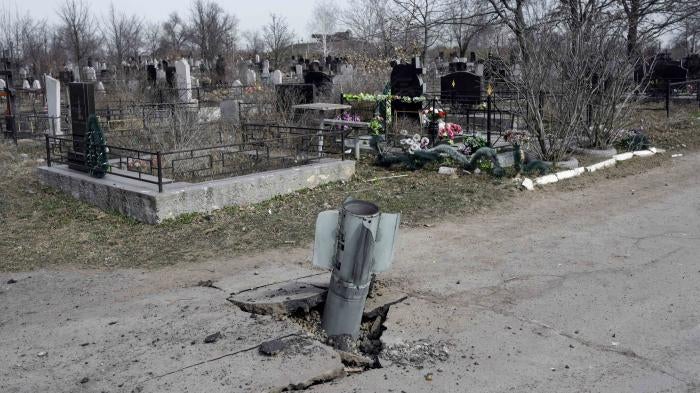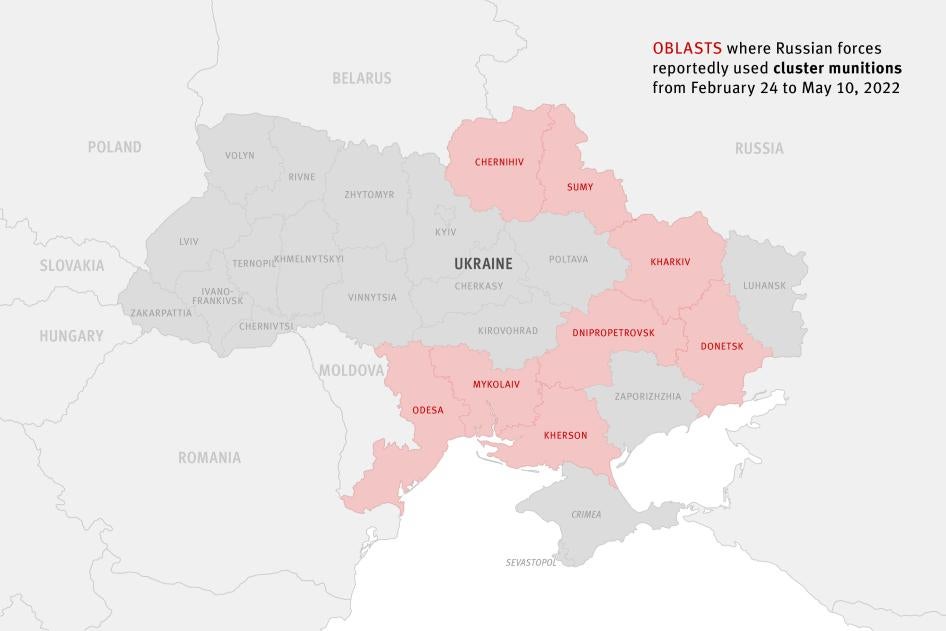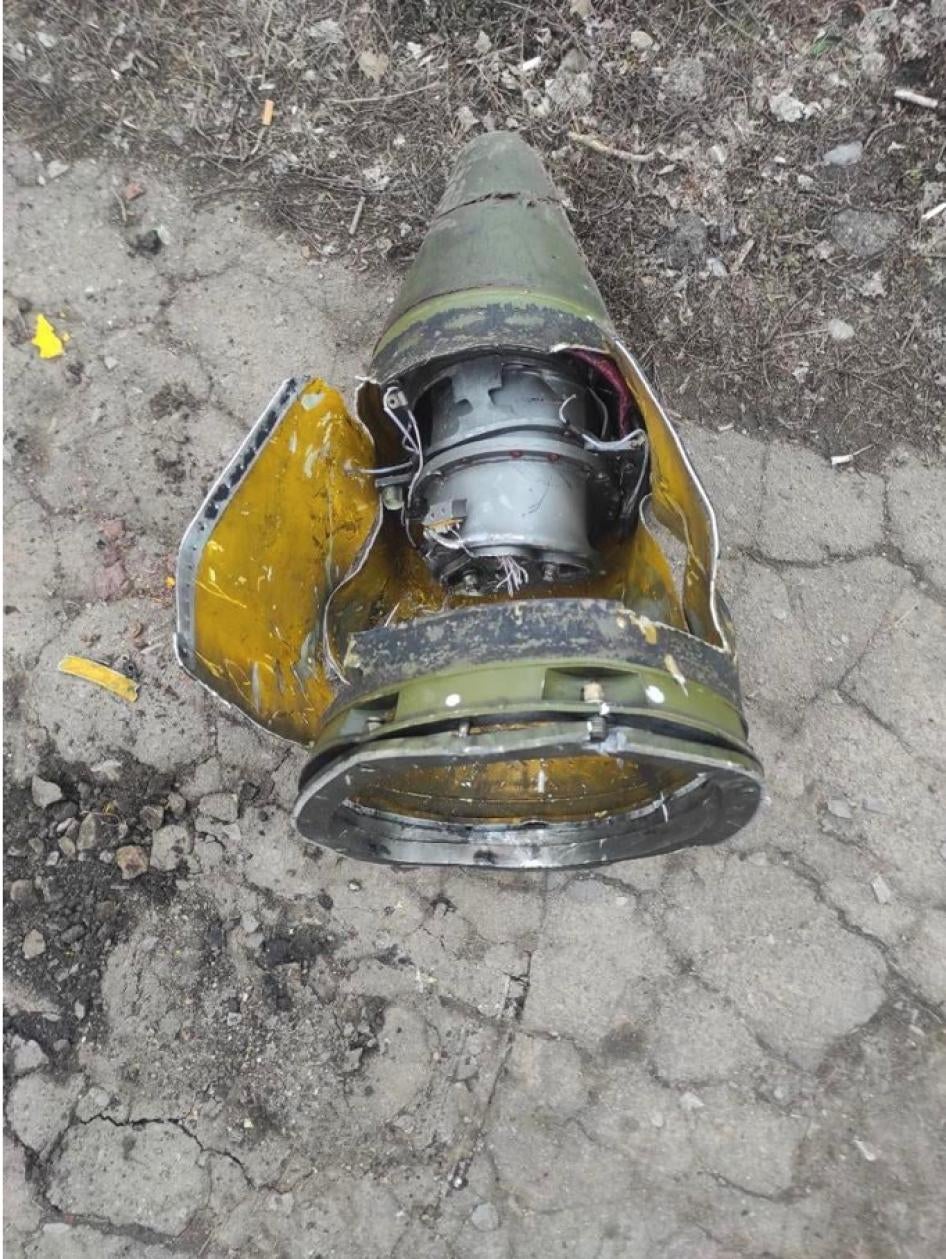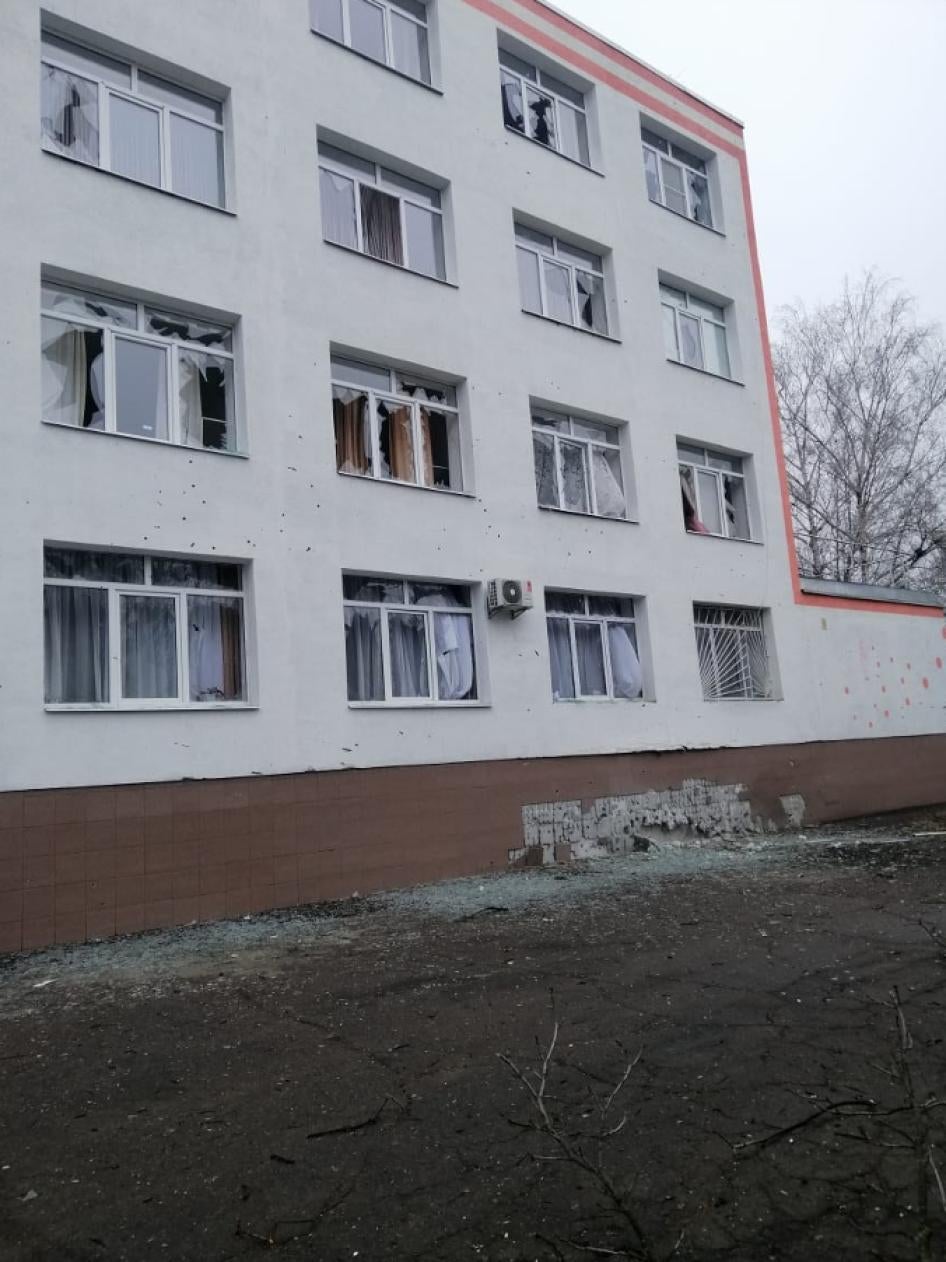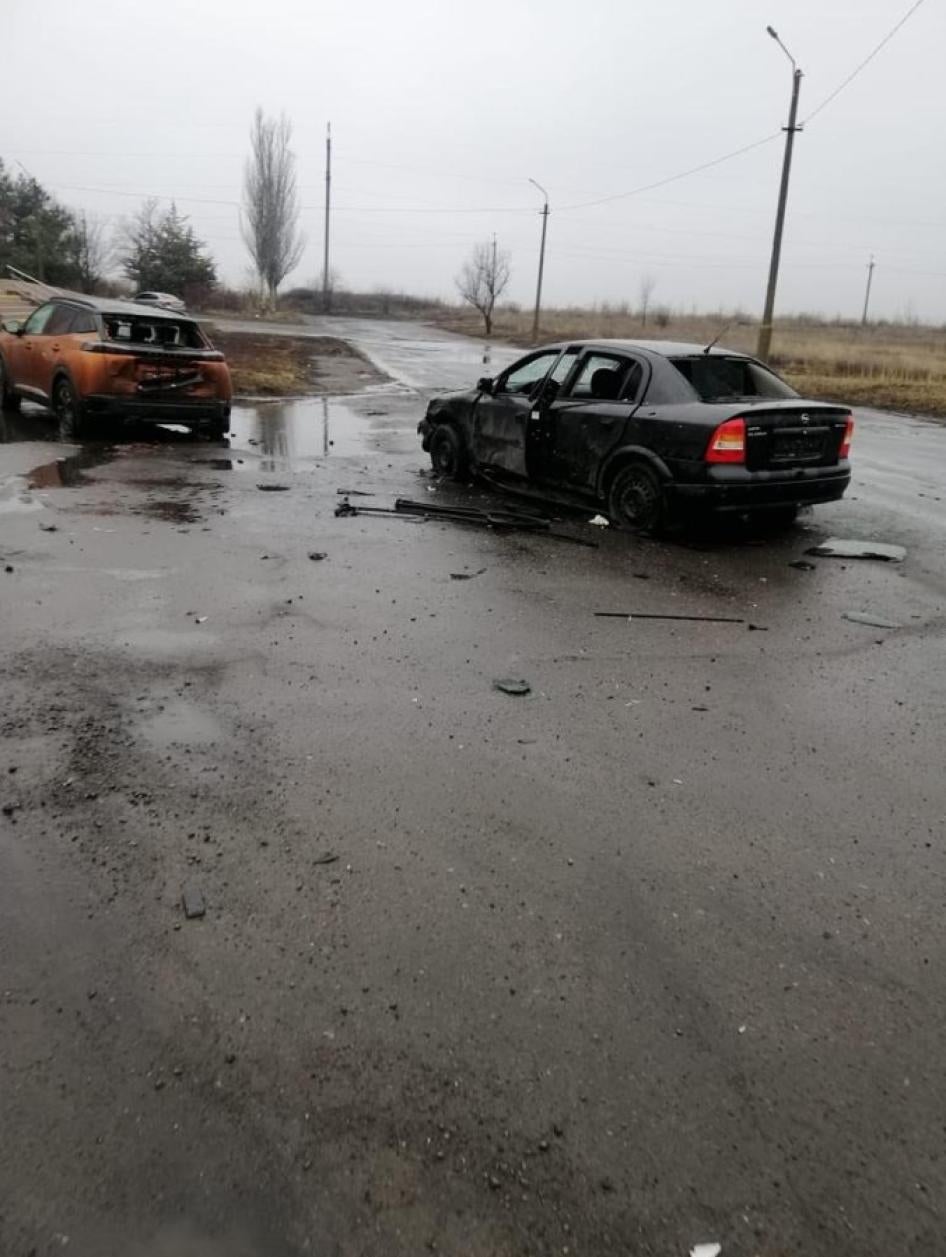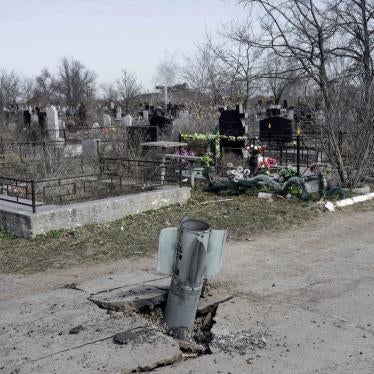Summary
This report presents the types of cluster munitions being used in the international armed conflict in Ukraine in 2022 and the civilian casualties immediately suffered and civilian objects damaged.
Since Russia’s invasion of Ukraine on February 24, 2022, Russian armed forces have used at least six types of cluster munitions in attacks that have caused hundreds of civilian casualties and damaged civilian objects, including homes, hospitals and schools. Evidence indicates that Ukrainian forces have also used cluster munitions at least once.
The exact number of Russian cluster munition attacks is not known, but hundreds have been documented, reported, or alleged to have occurred, many in populated areas. At least eight of Ukraine’s 24 oblasts (provinces) have been struck by cluster munitions: Chernihiv, Dnipropetrovsk, Donetsk, Kharkiv, Kherson, Mykolaiv, Odesa, and Sumy.
In the city of Mykolaiv, Russian forces launched cluster munition rockets into populated areas on March 7, 11 and 13, killing and injuring civilians and damaging homes, businesses and civilian vehicles. One of the March 13 attacks appeared to have killed 9 people who were waiting in line at a cash machine.
The Russian government has not denied using cluster munitions in Ukraine. It has accused Ukraine of using cluster munitions in the city of Donetsk on March 14, but this incident has not been independently confirmed.[1]
Media reports also indicate that Ukrainian forces used cluster munitions in Husarivka in Kharkiv oblast on March 6 or 7, when Russia forces occupied the village. The Ukrainian government has not denied this use of cluster munitions and stated that the Armed Forces of Ukraine “strictly adhere to the norms of international humanitarian law.”[2]
Thirty-six countries have condemned the cluster munition attacks in Ukraine, as have the European Union, the United Nations high commissioner for human rights, NATO’s secretary-general and others.
Cluster munitions can be delivered by rockets, missiles, and aircraft. They open to disperse dozens and even hundreds of small submunitions or bomblets over an area the size of a city block. Many submunitions fail to explode on initial impact, leaving duds that act like landmines, posing a threat to civilians for years and even decades.
The cluster munitions currently being used in Ukraine are launched from the ground in rockets and missiles with the exception of the RBK-series cluster bomb, which is delivered by aircraft. The cluster munitions were all manufactured in Russia, some as recently as 2021, or its predecessor the Soviet Union.
According to Ukraine’s State Emergency Service a total of 98,864 items of unexploded ordnance including submunitions and landmines have been cleared and destroyed in the war, as of May 9.[3] During the first seven weeks of the conflict, 29 workers were reportedly killed while doing demining and related work, and 73 were injured.[4] On April 17, three people working for Kharkiv’s emergency services were killed while clearing cluster munition remnants.[5]
Ukrainian government forces and Russia-backed armed groups have both used cluster munitions in the past; namely, in eastern Ukraine between July 2014 and February 2015, according to investigations conducted by Human Rights Watch, the Organization for Security and Co-operation in Europe (OSCE) monitoring mission, and others.[6]
The 2008 Convention on Cluster Munitions prohibits these weapons due to their indiscriminate effect and the long-lasting danger posed to civilians.[7] It provides a comprehensive ban and requires the destruction of stockpiles, clearance of areas contaminated by cluster munitions remnants, and assistance to victims. However, Russia and Ukraine are not among the treaty’s 110 states parties. Nonetheless, the use of cluster munitions in populated areas invariably violates international humanitarian law prohibitions on the use of weapons that cannot discriminate between civilians and combatants.[8]
Recommendations
To the parties to the conflict in Ukraine
- Immediately cease the use of cluster munitions and withdraw them from operational service; and
- Accede to the Convention on Cluster Munitions.
To all governments
- Urge Russia and Ukraine to stop using cluster munitions and encourage them to accede to the Convention on Cluster Munitions;
- Use every opportunity to condemn the use of cluster munitions in Ukraine, including via joint statements and resolutions;
- Commit not to assist Russia or Ukraine with any activities prohibited under the convention, such as the use and transfer of cluster munitions; and
- Urge all states to accede to the Convention on Cluster Munitions without delay.
Methodology
This report draws on a range of evidence collected by Human Rights Watch and other organizations. This includes:
- Human Rights Watch interviews with witnesses to cluster munition attacks in Ukraine since February 24, 2022, as well as with medical personnel, local authorities, deminers, and others;
- Videos and photos, obtained directly or via social media, showing the remnants of cluster munitions and submunitions as well as impact damage at the site of attacks;
- Satellite imagery analysis of areas that came under attack;
- Displays of cluster munition remnants cleared by government authorities; and
- Reporting by media and human rights organizations.
I. Types of Cluster Munitions
Six types of cluster munitions have been used in the 2022 international armed conflict in Ukraine. They are all launched from the ground in missiles and rockets except for the RBK-series cluster bomb, which is delivered by aircraft. The cluster munitions were all manufactured in Russia, some as recently as 2021, or by its predecessor state the Soviet Union.
Types of Cluster Munitions Used in Ukraine
- The 220mm 9M27K-series Uragan (“Hurricane”) cluster munition rocket has a range of 10 to 35 kilometers and delivers 30 9N235 fragmentation submunitions or 30 9N210 fragmentation submunitions. It was first reported used in Okhtyrka, Sumy oblast on February 25.[9] Both Russian and Ukrainian forces used this type of cluster munition rocket in the 2014-2015 conflict in eastern Ukraine.
- The 300mm 9M55K-series Smerch (“Tornado”) cluster munition rocket has a minimum range of 20 kilometers and a maximum range of 70 kilometers and delivers 72 9N235 or 9N210 fragmentation submunitions. It was first reported used in Kharkiv city on February 28.[10] Russian and Ukrainian forces previously used this type of cluster munition rocket in the 2014-2015 conflict.
- The 300mm 9M54-series guided missile delivered by 9K515 “Tornado-S” rockets has a 9M544 model that delivers 552 3B30 dual-purpose submunitions. The 3B30 submunitions were first spotted in Chornomorske, Kherson oblast on March 1.[11] Evidence shows the missiles were also used in Pokrovsk, Donetsk oblast on March 4.[12] The 9M549 model delivers 72 antipersonnel submunitions. Since these are modern systems only Russia possesses them. It is difficult to distinguish between remnants of the 9M544 and the 9M549 with the information currently available.
- The 9M79-series Tochka ballistic missile equipped with 9N123K warhead containing 50 9N24 fragmentation submunitions. First reported used in Vuhledar, Donetsk oblast on February 24.[13] Both Russia and Ukraine stockpile cluster munition variants of the Tochka ballistic missile.
- A cluster munition variant of the Iskander-M 9M723 ballistic missile was first reported used in Kramatorsk, Donetsk oblast on March 9, but no submunitions were documented at the time.[14] Russia stockpiles Iskander ballistic missiles.
- Also used have been 500 kilogram and 250 kilogram RBK-series air-dropped cluster bombs. The RBK-500 PTAB-1M cluster bomb containing 268 PTAB-1M submunitions was first reported used in Zatoka, Odesa oblast on March 4.[15] Local authorities also reported clearing an RBK-250 cluster bomb from the same location.[16] Both Russia and Ukraine stockpile RBK-series cluster bombs.
II. Civilian Harm from Cluster Munitions
The exact number of Russian cluster munition attacks that have occurred thus far in the 2022 conflict is not known, but hundreds have been documented, reported, or alleged, and mostly in populated areas. At least eight of the country’s 24 oblasts (provinces) have experienced the use of cluster munitions: Chernihiv, Dnipropetrovsk, Donetsk, Kharkiv, Kherson, Mykolaiv, Odesa, and Sumy.
The UN high commissioner for human rights, Michelle Bachelet, said on March 30 that her office had received credible allegations that Russian armed forces have used cluster munitions in populated areas at least 24 times.[17] Remnants of cluster munitions cleared by emergency services indicate that there have been hundreds of attacks.
As the following list shows, hundreds of civilians have been killed and injured in cluster munition attacks in Ukraine. These examples of civilian harm do not represent a comprehensive account of all instances or allegations of cluster munition use in the conflict.
Civilian Harm from Cluster Munition Attacks
- On February 24, Russian armed forces used a 9M79-series Tochka ballistic missile with 9N123K warhead containing 9N24 submunitions in an attack that struck outside a hospital in Vuhledar in Donetsk oblast, killing four civilians and injuring another 10, six of them healthcare workers. The attack damaged the hospital, an ambulance, and civilian vehicles.[18]
- On February 25, cluster munition attacks on the city of Kharkiv killed at least 9 civilians and injured 37 according to the UN Human Rights Monitoring Mission in Ukraine.[19] Airwars reported the use of a 9M55k Smerch rocket containing 9N210 or 9N235 submunitions outside a children’s hospital in which one civilian was killed and at least three injured.[20]]
- On February 25, Russian armed forces used a 9M27K-series Uragan cluster munition rocket in an attack on a preschool in Okhtyrka, Sumy oblast, killing three civilians including a child and injuring another child.[21]
- On February 28, Russian forces used a 9M55K-series Smerch cluster munition rocket in Kharkiv city, killing at least three civilians.[22]
- On March 4 or 5, a cluster munition attack killed a civilian man in the village of Krasne, south of Chernihiv city according to an investigation by Human Rights Watch into Russian air and ground attacks in Chernihiv city during the first half of March.
- On March 7, 11 and 13, a series of 9M27K Uragan rockets delivering 9N210 submunitions were used repeatedly in the city of Mykolaiv, killing civilians and damaging homes, businesses, and civilian vehicles.[23] One of the March 13 attacks killed 9 people who were waiting in line at a cash machine, local media reported. A man sheltering in his basement during a March 7 cluster munition rocket attack told Human Rights Watch, “I heard a whistling sound and the noise of many explosions.”[24]
- On March 14, Ukrainian forces allegedly using a Tochka-U ballistic missile with a cluster munition warhead in the city of Donetsk in an attack that the Russian government said killed 21 Ukrainian civilians and wounded 36.[25] Russia told the UN Human Rights Council, “There could have been dozens more victims of this attack. Only one cluster munition out of 50 detonated.”[26] Human Rights Watch has not been able to independently verify information relating to the reported attack, including if cluster munitions were used.
- On March 15, a civilian man and woman were wounded outside their home on the outskirts of Chernihiv city during a cluster munition attack in which three submunitions struck their yard. The Washington Post reported that a civilian was wounded during another cluster munition attack on Chernihiv city in March as he delivered water to civilians. Reporters saw remnants of cluster munitions littering fields outside Chernihiv.[27]
- On March 17, Russian cluster munition rocket attacks on Chernihiv killed 14 civilians and injured 21 others, according to city officials. At least one civilian man was wounded outside a children’s hospital in Chernhiv and the hospital’s walls and windows were damaged. Clearance teams destroyed the remnants of an Uragan cluster munition rocket and four unexploded 9N210 submunitions remaining from the attack.
- On March 25, a group of approximately 50 journalists and humanitarian workers travelling to the city of Chernihiv were in the Ukrainian-held village of Annisiv in Chernihiv oblast when they came under rocket attack from Russian forces. Ukrainian journalist Andriy Tsapilenko was wounded when one strike landed near where he was taking cover beside his car. At the time, Tsapilenko told Human Rights Watch there were no more than five Ukrainian soldiers present. Video footage filmed at the attack site shows the cargo sections of two cluster munition rockets stuck into the ground. The damage to Tsapilenko’s vehicle was consistent with that of pre-formed fragments dispersed by submunitions carried in the Uragan series rockets. Tsapilenko told Human Rights Watch that first he heard a big explosion and then smaller explosions coming closer.
- On April 4, a cluster munition rocket hit a city hospital in Mykolaiv during a visit by the humanitarian medical organization Médecins Sans Frontières.[28] The regional governor reported that Russian shelling of the city killed 10 people and injured 61 that day.[29]
- On April 8, a Tochka-U ballistic missile carrying 50 9N24 submunitions was reported by the BBC and others to have been used in an attack on the railway station in Kramatorsk city, Donetsk oblast, which killed approximately 50 people—civilians fleeing the conflict—and wounded dozens more.[30]
- On April 12, a cluster munition attack at about 1:30 p.m. on the town of Babai outside Kharkiv city killed one civilian—an electrician repairing a power pylon—and wounded two civilians in the street.[31]
Cluster munition remnants pose continued danger long after attacks, especially unexploded submunitions. According to Ukraine's State Emergency Service a total of 98,864 items of unexploded ordnance including submunitions and landmines have been cleared and destroyed in the war, as of May 9.[32] During that period, 29 workers were killed while doing demining and related work, and 73 have been maimed or otherwise injured.[33]
On April 17, three people working for Kharkiv’s emergency services were reportedly killed while clearing cluster munition remnants.[34] A civilian in Mykolaiv reportedly lost his hand and received severe internal injuries after he went to clear a submunition that detonated minutes after it was deployed.[35] He told the Independent, “I thought they were safe. Big mistake.”[36]
III. Russia’s Response
The Russian government has generally avoided commenting on its use of cluster munitions in Ukraine but has not denied using the weapons. Instead, it has sought to draw attention to past use of cluster munitions by NATO member states against Yugoslavia in 1999.[37]
Russian officials claim the Ukrainian armed forces fired a Tochka-U tactical missile with a cluster munition warhead in Donetsk city on March 14 in what they have called “a war crime.”[38] Human Rights Watch has not been able to independently verify information relating to the reported attack, including if cluster munitions were used.
Russia previously used cluster munitions in eastern Ukraine in 2014 until a 2015 ceasefire, causing numerous civilian casualties.[39] Russia repeatedly drew attention to Ukraine’s use of cluster munitions at the time, but never acknowledged its role in using cluster munitions. Russia has never explicitly denied its direct involvement in supporting the Syrian government’s cluster munition attacks, which Russian Foreign Minister Sergey Lavrov told Human Rights Watch in 2016 were carried out in compliance with international humanitarian law.[40]
Russia is the most vocal state critic of the Convention on Cluster Munitions, which it says it cannot join as it regards cluster munitions as “a legitimate type of weapon that is not banned by international humanitarian law and plays a significant role in the defense interests of Russia.”[41] Russia last participated as an observer in a meeting of the convention in 2012.
IV. Ukraine’s Response
Ukrainian officials have expressed grave concern over Russia’s use of cluster munitions in the conflict. For example, Ukraine’s prosecutor general, Iryna Venediktova, told a UN Security Council debate held on April 27, 2022 that Russia’s use of cluster munitions in populated areas is proof that it “blatantly disregards international humanitarian law.”[42] Venediktoya has described cluster munitions as “one of the most treacherous weapons, operating indiscriminately and causing superfluous injury and unnecessary suffering among civilians.”[43]
However, Ukraine has not denied credible evidence of its own use of cluster munitions in the current conflict. A report by the New York Times strongly suggests that Ukrainian forces used Uragan cluster munition rockets in Husarivka in Kharkiv oblast on March 6 or 7, when Russian forces occupied the village.[44] The Times updated the April 18 article to include the following response from Ukraine’s military:
The Armed Forces of Ukraine strictly adhere to the norms of international humanitarian law. One of our constant priorities is the security of the civilian population. We do not open fire or destroy civilian objects, nor do we use weapons and methods prohibited by the Geneva Conventions.
Ukraine inherited a large stockpile of cluster munitions after the break-up of the Soviet Union and used them in Donetsk and Luhansk in 2014 and 2015.[45] At that time, the Ukrainian government repeatedly denied using cluster munitions and blamed the attacks on pro-Russian separatist groups and the Russian armed forces.
Ukraine has not taken any steps to join the Convention on Cluster Munitions and last participated as an observer in a meeting of the convention in 2014.[46]
V. International Response
The Convention on Cluster Munitions obligates each state party to “promote the norms it establishes and … make its best efforts to discourage States not party to this Convention from using cluster munitions.”[47] States parties should firmly oppose any use of cluster munitions by any warring party under any circumstances.[48]
In accordance with this explicit provision and the emerging international norm, the use of cluster munitions in Ukraine been condemned by at least 36 states: Albania, Andorra, Austria, Belgium, Bosnia and Herzegovina, Canada, Costa Rica, Denmark, Estonia, Finland, France, Georgia, Germany, Greece, Guatemala, Iceland, Ireland, Italy, Latvia, Liechtenstein, Lithuania, Mexico, Republic of Moldova, Monaco, Montenegro, Netherlands, New Zealand, North Macedonia, Norway, Philippines, Poland, Romania, San Marino, Sweden, Switzerland, and the United Kingdom.[49]
As the current president of the Convention on Cluster Munitions, the United Kingdom has expressed grave concern at the use of cluster munitions in the Russian invasion of Ukraine. It “calls upon all those that continue to use such weapons to cease immediately, and calls upon all states that have not yet done so to join the Convention without delay.”[50]
The cluster munition attacks in Ukraine have also been condemned by the European Union and its member and candidate states, the UN high commissioner for human rights and UN special rapporteurs and experts. It has also been condemned by the nongovernmental Cluster Munition Coalition, which is chaired by Human Rights Watch. The condemnations of the use of cluster munitions in Ukraine in 2022 as well as strong media coverage and public outcry demonstrate the growing stigma against these weapons.
The United States government has expressed deep alarm at Russia’s use of cluster munitions in Ukraine.[51] However, it backtracked on a comment from one senior US official who criticized cluster munitions as unacceptable weapons that “have no place on the battlefield.”[52] This reflects the unwillingness of the US to join the convention. On April 22, a group of 27 US congressmen called cluster munitions “barbaric and indiscriminate weapons” and said that they “strongly believe the credible allegations of Russian use of cluster munitions necessitate a change to the administration’s cluster munitions policy” to join the convention.[53]
On March 4, NATO Secretary-General Jens Stoltenberg called Russia’s use of cluster munitions in Ukraine “inhumane” and “in violation” of international law.[54] All of NATO’s 30 member states have ratified the Convention on Cluster Munitions except Estonia, Greece, Latvia, Poland, Romania, Turkey, and the United States.
States that have joined the Convention on Cluster Munitions are prohibited from assisting, encouraging or inducing anyone to engage in any activity banned under the convention. Therefore, any NATO or other military operation in support of Ukraine in which states parties participate could not assist with the use and transfer of cluster munitions.
Acknowledgments
This report was researched and written by Mary Wareham, advocacy director for the Arms Division at Human Rights Watch. This report was edited by Steve Goose, Arms director. James Ross, legal and policy director, and Fred Abrahams, program director, provided legal and programmatic reviews respectively. Mark Hiznay, Tanya Lokshina, and Rich Weir provided additional review. Production assistance was provided by Susan Aboeid, associate with the Arms division. The report was prepared for publication by Travis Carr, senior publications coordinator. Kathleen Rose, senior editor, reviewed the press release accompanying the report.
We would like to thank the Cluster Munition Coalition for its assistance in disseminating this report.
